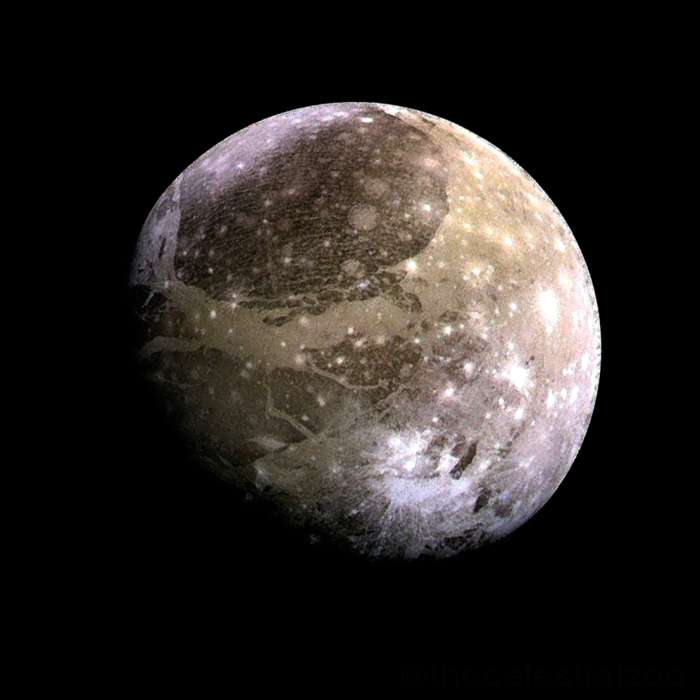Jupiter has 79 known moons and Ganymede is the largest of them; actually, it is the most massive of all the moon’s in the Solar System. And the good news is that Ganymede has water vapour in its atmosphere. The discovery is significant since Scientists always look for water in the deep space for exploration of the possibility of life beyond earth. Now NASA has revealed that astronomers, for the first time, have uncovered evidence of water vapour in the atmosphere of Jupiter’s moon Ganymede. This water vapour forms when solid ice from the moon surface turns to gas.
Interestingly, the scientists used new and archival datasets from NASA’s Hubble Space Telescope to make this discovery, which was published in the journal Nature Astronomy.
Ganymede has more water than Earth’s oceans
This research has thrown up evidence of the Ganymede moon containing more water than all of Earth’s oceans. However, its surface is frozen solid due to very low temperatures. Consequently, the ocean on Ganymede resides around 100 miles below the crust; the reason why the water vapour does not result from the evaporation of the ocean.
To arrive at this conclusion with the evidence of water vapour, astronomers re-examined Hubble observations from the last two decades.
What were the 1998 findings?
In 1998, the first ultraviolet (UV) images of Ganymede taken by Hubble’s Space Telescope Imaging Spectrograph revealed colourful ribbons of electrified gas called auroral bands and concluded that the moon has a weak magnetic field.
Previous far-ultraviolet observations of oxygen emissions were used to infer sputtered molecular oxygen (O2) as an atmospheric constituent, but an expected sublimated water (H2O) component remained undetected.
No atomic oxygen in Ganymede atmosphere
As part of a large observing program to support NASA‘s Juno mission in 2018, Lorenz Roth of the KTH Royal Institute of Technology in Stockholm, Sweden led the team that set out to measure the amount of atomic oxygen with Hubble.
The team’s analysis combined the data from two instruments: Hubble’s Cosmic Origins Spectrograph in 2018 and archival images from the Space Telescope Imaging Spectrograph (STIS) from 1998 to 2010.
To their surprise, and contrary to the original interpretations of the data from 1998, they discovered there was hardly any atomic oxygen in Ganymede’s atmosphere. This means there must be another explanation for the apparent differences in these UV aurora images.
Ice surface releases water vapour around noon
Roth and his team then took a closer look at the relative distribution of the aurora in the UV images. Ganymede’s surface temperature varies strongly throughout the day, and around noon near the equator, it may become sufficiently warm that the ice surface releases (or sublimates) some small amounts of water molecules.
In fact, the perceived differences in the UV images are directly correlated with where water would be expected in the moon’s atmosphere.
“So far only the molecular oxygen had been observed,” explained Roth.
“This is produced when charged particles erode the ice surface. The water vapour that we measured now originates from ice sublimation caused by the thermal escape of water vapour from warm icy regions.”
Juice mission to Jupiter in 2029
This finding adds anticipation to ESA (European Space Agency)’s upcoming mission, JUICE, which stands for Jupiter ICy moons Explorer. JUICE is the first large-class mission in ESA’s Cosmic Vision 2015-2025 program.
Planned for launch in 2022 and arrival at Jupiter in 2029, it will spend at least three years making detailed observations of Jupiter and three of its largest moons, with particular emphasis on Ganymede as a planetary body and potential habitat.
Ganymede was identified for detailed investigation because it provides a natural laboratory for analysis of the nature, evolution and potential habitability of icy worlds in general, the role it plays within the system of Galilean satellites, and its unique magnetic and plasma interactions with Jupiter and its environment.
“Our results can provide the JUICE instrument teams with valuable information that may be used to refine their observation plans to optimize the use of the spacecraft,” added Roth.
Mission for insights on habitability of Jupiter
Right now, NASA’s Juno mission is taking a close look at Ganymede and recently released new imagery of the icy moon. Juno has been studying Jupiter and its environment, also known as the Jovian system, since 2016.
Understanding the Jovian system and unravelling its history, from its origin to the possible emergence of habitable environments, will provide us with a better understanding of how gas giant planets and their satellites form and evolve. In addition, new insights will hopefully be found on the habitability of Jupiter-like exoplanetary systems.
(Story sourced from NASA website)









Musk’s college photo with sweetheart auctioned
Covid symptoms despite jab? How it depends on your vaccine
An apology after mass firing: Viral saga of Better.com CEO